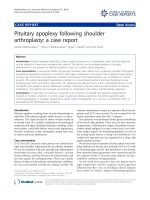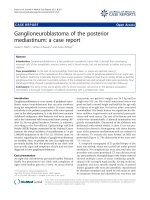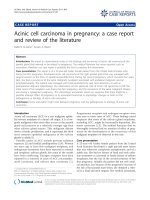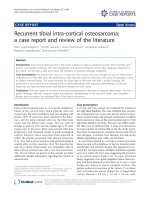Báo cáo y học: "Stenotrophomonas maltophilia prosthetic valve endocarditis: a case report" pot
Bạn đang xem bản rút gọn của tài liệu. Xem và tải ngay bản đầy đủ của tài liệu tại đây (167.46 KB, 3 trang )
BioMed Central
Page 1 of 3
(page number not for citation purposes)
Journal of Medical Case Reports
Open Access
Case report
Stenotrophomonas maltophilia prosthetic valve endocarditis: a case
report
Sophie Bayle
1
, Clarisse Rovery
1
, Pascal Sbragia
2
, Didier Raoult
3
and
Philippe Brouqui*
1
Address:
1
Service des maladies infectieuses et tropicales, Hôpital Nord, Chemin des Bourrelys, 13915 Marseille cedex 20, France,
2
Service de
cardiologie, Hôpital Nord, Chemin des Bourrelys, 13915 Marseille cedex 20, France and
3
Service de Microbiologie, Hôpital de la Timone,
Marseille, France
Email: Sophie Bayle - ; Clarisse Rovery - ; Pascal Sbragia -
hm.fr; Didier Raoult - ; Philippe Brouqui* -
* Corresponding author
Abstract
Introduction: Stenotrophomonas maltophilia is an environmental bacterium increasingly involved in
nosocomial infections and resistant to most antibiotics. It is important to recognize and efficiently
treat infections with this bacterium as soon as possible.
Case presentation: We present a case of Stenotrophomonas maltophilia prosthetic valve
endocarditis secondary to an indwelling catheter infection. The patient was cured without surgery.
We review other cases of S. maltophilia endocarditis from the literature and describe the
peculiarities of this case.
Conclusion: S. maltophilia endocarditis is a rare disease that is often hospital-acquired and related
to an indwelling catheter infection. The high lethality is likely related to the intrinsic resistance of
nosocomial bloodstream infections to commonly prescribed antibiotics.
Introduction
Stenotrophomonas maltophilia is a Gram-negative aerobic
bacillus widely distributed in natural and human environ-
ments and has become increasingly responsible for noso-
comial infections such as bacteremia, pneumonia, urinary
tract infections, skin and soft tissue infections, ocular
infections and meningitis [1]. It is generally considered as
an opportunist pathogen with potential risk factors being:
malignancies, debilitating illnesses, prior therapy with
broad-spectrum antibiotics, chronic respiratory diseases,
especially cystic fibrosis, prolonged endotracheal intuba-
tion and indwelling vascular catheters. S. maltophilia infec-
tive endocarditis (IE) is a rare and poorly described
disease [2-5]. Here, we present the 29th reported case of S.
maltophilia endocarditis along with a literature review.
Case presentation
In November 2005, a 34-year-old Algerian woman was
admitted to the infectious disease department for a sus-
pected prosthetic mitral valve IE. She had a medical his-
tory of acute rheumatic fever when she was 10 years old.
She had a mitral valve replacement with a prosthetic
mechanic valve eight years ago. She was hospitalized at
the end of a recent pregnancy because she needed intrave-
nous heparin therapy in relay of oral anticoagulant for
prevention of thrombosis of the mechanical valve pros-
thesis. Three days after delivery, she presented with a fever
Published: 23 May 2008
Journal of Medical Case Reports 2008, 2:174 doi:10.1186/1752-1947-2-174
Received: 5 September 2007
Accepted: 23 May 2008
This article is available from: />© 2008 Bayle et al; licensee BioMed Central Ltd.
This is an Open Access article distributed under the terms of the Creative Commons Attribution License ( />),
which permits unrestricted use, distribution, and reproduction in any medium, provided the original work is properly cited.
Journal of Medical Case Reports 2008, 2:174 />Page 2 of 3
(page number not for citation purposes)
and peripheral catheter-related infection. The catheter was
in place for six days; it was inserted at the admission of the
patient to the high-risk pregnancy unit. The site of the
catheter insertion appeared inflammatory and indurate.
All three blood cultures (automated blood culture
BACTEC 9240 system, Becton Dickinson, Le pont de
Claix, France) grew on day 2 with S. maltophilia. Tran-
soephageal echocardiography (TE) performed one day
after the appearance of fever showed two small vegeta-
tions on the mitral mechanic valve without dehiscence.
Based on the criteria established by Duke, the diagnosis of
prosthetic mitral valve IE caused by S. maltophilia was con-
firmed. She was first treated empirically with vancomycin
and gentamicin for 24 h. Antibiotics were then modified
when we discovered Gram-negative bacillus growing in
the blood cultures: imipenem and gentamicin were
administered. She was treated with trimethoprim-sulfam-
ethoxazole (SXT, trimethoprim (TMP) 4800 mg/day and
sulfamethoxazole (SMZ) 960 mg/day) and gentamicin 3
mg/kg/day intravenously in accordance with antimicro-
bial susceptibility. In fact, effective treatment was started
two days after the onset of disease and she had no fever on
day 2 of this treatment. No cardiac complications
occurred. Gentamicin was discontinued after seven days.
SXT was then given per os (TMP 4800 mg/day and SMZ
960 mg/day). On day 8, a TE showed no vegetation. Anti-
biotics were continued for a total duration of six weeks.
She remained well and showed no signs of fever and had
a normal TE at her three-month follow-up visit.
Discussion
Here we present the 29th reported case of S. maltophilia
endocarditis. S. maltophilia IE is a rare disease [1-5]. In
2002, Crum et al reported one case of S. maltophilia IE and
reviewed 24 additional cases [3]. A Medline search
revealed three additional cases of S. maltophilia IE [2,4,5].
The characteristics of reported cases of S. maltophilia IE are
summarized in additional files 1 [see additional file 1].
Underlying risk factors were found in all patients (27/27)
including 8/27 (29.6%) of intravenous drug users
(IVDUs). Among S. maltophilia IE, 14/27 (51.94%) were
of nosocomial origins (4/14, 28.6% being catheter-related
infections and 10/14, 71.4% related to recent valve
replacement (< 9 months) whereas 13/27 (48.1%) were
community-acquired (8/13, 61.5% being acquired in
IVDUs).S. maltophilia is intrinsically resistant to many
common antibiotics and broad-spectrum β-lactams, such
as imipenem. Combination antibiotherapy is indicated
with SXT as the agent of choice [1-6]. Therapy for S. mal-
tophilia infections is problematic because of the broad
resistance to antibiotics that is characteristic of this organ-
ism. Antibiotic treatments currently used for nosocomial
primary bloodstream infections [7], such as vancomycin
and imipenem, have no effect on S. maltophilia. This may
explain the high mortality reported (9/28, 32%) and the
frequency of complications (17/25, 68%) in S. maltophilia
IE. Surgery is necessary in 9/17 (52.9%) cases involving
prosthetic valves. Indeed, only 6/17 (35.3%) of S. mal-
tophilia prosthetic valve IE are cured without surgery.
S. maltophilia endocarditis is a rare and severe disease,
often nosocomial and related to central indwelling cathe-
ter infection. Our case is unusual as IE was secondary to
peripheral catheter-related infection. As S. Maltophilia is
resistant to the first line of antibiotic treatment used in
these cases, empiric antibiotic treatment is often ineffec-
tive. Delay in effective antibiotic treatment is a major risk
factor for mortality in S. Maltophilia bacteremia [8]. As a
consequence, it is important to identify this microorgan-
ism as quickly as possible. Standard bacterial identifica-
tion and susceptibility testing is normally a 48-h process.
Polymerase chain reaction (PCR) can be used to decrease
the identification time for Gram-negative bacteria isolated
from blood culture, which has also been suggested for
Pseudomonas aeruginosa infections [9]. In the light of this
case report, it is also important to recall that guidelines on
the prevention of intravascular device-related blood-
stream infection have to be generalized and respected
[10]. In fact, the catheter was left in place for too long in
this previously healthy woman, and nosocomial infection
could have easily been prevented in this patient.
Conclusion
S. maltophilia is a rare and severe disease, and is usually
hospital-acquired. It is important to identify this microor-
ganism as quickly as possible since S. maltophilia is resist-
ant to first line antibiotic therapy used in case of
nosocomial infections. This case report also emphasizes
that prevention of intravascular device-related blood-
stream infection is a major measure to prevent this very
severe disease.
Competing interests
The authors declare that they have no competing interests.
Authors' contributions
SB, CR, PB and DR contributed to the clinical work-up of
the patient and writing-up of the manuscript. PS was in
charge of the patient in the department of cardiology and
performed the echocardiography. All authors read and
approved the final manuscript.
Consent
Written informed consent was obtained from the patient
for publication of this case report and accompanying
images. A copy of the written consent is available for
review by the Editor-in-Chief of this journal.
Publish with BioMed Central and every
scientist can read your work free of charge
"BioMed Central will be the most significant development for
disseminating the results of biomedical research in our lifetime."
Sir Paul Nurse, Cancer Research UK
Your research papers will be:
available free of charge to the entire biomedical community
peer reviewed and published immediately upon acceptance
cited in PubMed and archived on PubMed Central
yours — you keep the copyright
Submit your manuscript here:
/>BioMedcentral
Journal of Medical Case Reports 2008, 2:174 />Page 3 of 3
(page number not for citation purposes)
Additional material
References
1. Candel FJ, Lopez R, Valdivia A, Nunez MJ, Roca-Arbones V, JJ PG:
[Endocarditis due to Stenotrophomonas maltophilia].
Enferm Infecc Microbiol Clin 2002, 20:477-478.
2. Crum NF, Utz GC, Wallace MR: Stenotrophomonas maltophilia
endocarditis. Scand J Infect Dis 2002, 34:925-927.
3. Lopez RR, Lado Lado FL, Sanchez A, Rodriguez L I, Gamallo TR,
Lorenzo Z V, Rodriguez-Otero L: [Endocarditis caused by Sten-
otrophomonas maltophilia: report of a case and review of lit-
erature]. An Med Interna 2003, 20:312-316.
4. Meimoun P, Mainardi JL, Berrebi A, Choucair J, Chevalier P, Buu-Hoi
A, Gutmann L, Carpentier A: [Stenotrophomonas maltophilia
endocarditis following mitral valve prosthesis implantation.
Report of a case]. Arch Mal Coeur Vaiss 1999, 92:1389-1392.
5. Senol E: Stenotrophomonas maltophilia: the significance and
role as a nosocomial pathogen. J Hosp Infect 2004, 57:1-7.
6. Muder RR, Harris AP, Muller S, Edmond M, Chow JW, Papadakis K,
Wagener MW, Bodey GP, Steckelberg JM: Bacteremia due to
Stenotrophomonas (Xanthomonas) maltophilia: a prospec-
tive, multicenter study of 91 episodes. Clin Infect Dis 1996,
22:508-512.
7. Mermel LA, Farr BM, Sherertz RJ, Raad II, O'Grady N, Harris JS, Cra-
ven DE: Guidelines for the Management of Intravascular
Catheter–Related Infections. Clin Infect Dis 2001, 32:1249-1272.
8. Wu PS, Lu CY, Chang LY, Hsueh PR, Lee PI, Chen JM, Lee CY, Chan
PC, Chang PY, Yang TT, Huang LM: Stenotrophomonas mal-
tophilia bacteremia in pediatric patients a 10-year analysis.
J Microbiol Immunol Infect 2006, 39:144-149.
9. Jaffe RI, Lane JD, Bates CW: Real-time identification of Pseu-
domonas aeruginosa direct from clinical samples using a
rapid extraction method and polymerase chain reaction
(PCR). J Clin Lab Anal 2001, 15:131-137.
10. N.P. OG, M A, E.P. D, D.G. M, H. M, R.D MC, L.A M, M.L P, I.I R, A
R, R.A W: Guidelines for the prevention of intravascular cath-
eter-related infections. Clin Infect Dis 2002,
35:1281-1307.
Additional file 1
Stenotrophomonas maltophilia infectious endocarditis case reports in the
literrature. The data provided represent the Stenotrophomonas mal-
tophilia infectious endocarditis cases reported in the literrature.
Click here for file
[ />1947-2-174-S1.doc]









